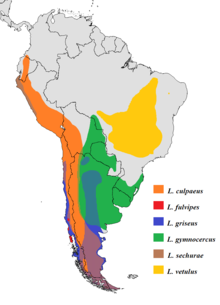Genus of carnivores
The South American foxes (Lycalopex), commonly called raposa in Portuguese, or zorro in Spanish, are a genus from South America of the subfamily Caninae. Despite their name, they are not true foxes, but are a unique canid genus more closely related to wolves and jackals than to true foxes; some of them resemble foxes due to convergent evolution. The South American gray fox, Lycalopex griseus, is the most common species, and is known for its large ears and a highly marketable, russet-fringed pelt.
The second-oldest known fossils belonging to the genus were discovered in Chile, and date from 2.0 to 2.5 million years ago, in the mid- to late Pliocene.[4] The Vorohué Formation of Argentina has provided older fossils, dating to the Uquian to Ensenadan (Late Pliocene).[5]
Names
The common English word "zorro" is a loan word from Spanish, with the word originally meaning "fox". Current usage lists Pseudalopex (literally: "false fox") as synonymous with Lycalopex ("wolf fox"), with the latter taking precedence.[1][6] In 1895, Allen classified Pseudalopex as a subgenus of Canis, establishing the combination Canis (Pseudalopex), a name still used in the fossil record.[2]
Species
Species currently included in this genus include:[1]
In 1914, Oldfield Thomas established the genus Dusicyon, in which he included these zorros. They were later reclassified to Lycalopex (via Pseudalopex) by Langguth in 1975.[1]
Phylogeny
The following phylogenetic tree shows the evolutionary relationships between the Lycalopex species, based on molecular analysis of mitochondrial DNA control region sequences.[7]
Relationship with humans
The zorros are hunted in Argentina for their durable, soft pelts. They are also often labelled 'lamb-killers'.[citation needed]
In his diary of his well-known 1952 traveling with the young Che Guevara,[8] Alberto Granado mentions talking with seasonal workers employed on vast sheep farms, who told him of a successful campaign by the ranch owners to exterminate the foxes who were preying on lambs. The ranchers offered a reward of one Argentinian peso for the body of a dead male fox and as much as five pesos for a female fox; to impoverished workers in the early 1950s, five pesos were a significant sum. Within a few years, foxes became virtually extinct in a large part of Argentina.
The Fuegian dog (Spanish: perro yagán, perro fueguino), also known as the Yaghan dog, was a domesticated form of the culpeo (Lycalopex culpaeus),[9] unlike other domesticated canids which were dogs and silver foxes. This means different canid species have been domesticated multiple times by humans independently.
References
- ^ a b c d Wozencraft, W. C. (2005). "Order Carnivora". In Wilson, D. E.; Reeder, D. M. (eds.). Mammal Species of the World: A Taxonomic and Geographic Reference (3rd ed.). Johns Hopkins University Press. ISBN 978-0-8018-8221-0. OCLC 62265494.
- ^ a b "Canis (Pseudalopex) australis Kerr 1792". Fossilworks. Gateway to the Paleobiology Database. Retrieved 15 December 2021.
- ^ Wilson, D. E.; Reeder, D. M., eds. (2005). Mammal Species of the World: A Taxonomic and Geographic Reference (3rd ed.). Johns Hopkins University Press. ISBN 978-0-8018-8221-0. OCLC 62265494.
- ^ Lucherini, M. & Luengos Vidal, E. M. (2008). "Lycalopex gymnocercus (Carnivora: Canidae)". Mammalian Species. 820: Number 820, pp. 1–9. doi:10.1644/820.1. hdl:11336/115900.
- ^ a b Vorohuen (sic; Vorohué) Formation at Fossilworks.org
- ^ Lucherini, M. (2016). "Lycalopex culpaeus". IUCN Red List of Threatened Species. 2016: e.T6929A85324366. doi:10.2305/IUCN.UK.2016-1.RLTS.T6929A85324366.en. Retrieved 11 November 2021.
- ^ Tchaicka, Ligia; Freitas, Thales Renato Ochotorena de; Bager, Alex; Vidal, Stela Luengos; Lucherini, Mauro; Iriarte, Agustín; Novaro, Andres; Geffen, Eli; Garcez, Fabricio Silva; Johnson, Warren E.; Wayne, Robert K.; Eizirik, Eduardo (2016). "Molecular assessment of the phylogeny and biogeography of a recently diversified endemic group of South American canids (Mammalia: Carnivora: Canidae)" (PDF). Genetics and Molecular Biology. 39 (3): 442–451. doi:10.1590/1678-4685-GMB-2015-0189. PMC 5004827. PMID 27560989.
- ^ TRAVELLING WITH CHE GUEVARA by Alberto Granado
- ^ Petrigh, Romina S.; Fugassa, Martin H. (December 13, 2013). "Molecular identification of a Fuegian dog belonging to the Fagnano Regional Museum ethnographic collection, Tierra del Fuego" (PDF). Quaternary International. 317: 14–18. Bibcode:2013QuInt.317...14P. doi:10.1016/j.quaint.2013.07.030. Archived from the original (PDF) on December 20, 2016. Retrieved September 2, 2020.
Further reading
Wikimedia Commons has media related to Pseudalopex.























